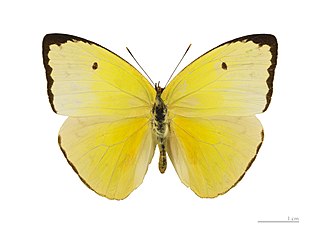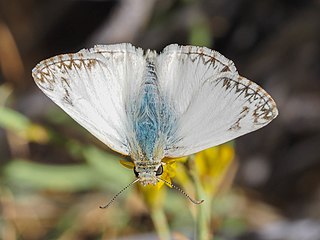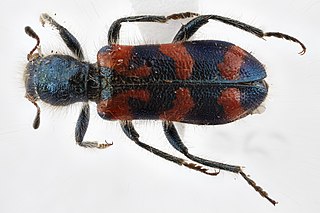
Eurytides marcellus, the zebra swallowtail, is a swallowtail butterfly native to the eastern United States and south-eastern Canada. It is the state butterfly of Tennessee. Its distinctive wing shape and long tails make it easy to identify, and its black-and-white-striped pattern is reminiscent of a zebra. The butterflies are closely associated with pawpaws, and are rarely found far from these trees. The green or black caterpillars feed on the leaves of various pawpaw species, while the adults feed on flower nectar and minerals from damp soil.

Epargyreus clarus, the silver-spotted skipper, is a butterfly of the family Hesperiidae. It is claimed to be the most recognized skipper in North America. E. clarus occurs in fields, gardens, and at forest edges and ranges from southern Canada throughout most of the United States to northern Mexico, but is absent in the Great Basin and western Texas.

Cecropterus lyciades, the hoary edge, is a species of skipper in the family Hesperiidae which can be seen throughout the eastern United States in open woodlands, deciduous mixed forest and sandy areas. Cecropterus lyacides is an uncommon butterfly that is named after an underlying whitish patch on the hindwing patch.

Papilio canadensis, the Canadian tiger swallowtail, is a species of butterfly in the family Papilionidae. It was once classified as a subspecies of Papilio glaucus.

Nymphalis vaualbum or N. l-album, the Compton tortoiseshell, or false comma, is a species of butterfly in the family Nymphalidae.

Callophrys gryneus, the juniper hairstreak or olive hairstreak, is a butterfly native to North America. It belongs in the family Lycaenidae.

Lycaena dorcas is a species of butterfly in the family Lycaenidae, the gossamer-winged butterflies. Its common names include dorcas copper and cinquefoil copper. The species was first described by William Kirby in 1837. It is native to North America. The species L. dospassosi was once included in L. dorcas.

Euptoieta claudia, the variegated fritillary, is a North and South American butterfly in the family Nymphalidae. Even though the variegated fritillary has some very different characteristics from the Speyeria fritillaries, it is still closely related to them. Some of the differences are: variegated fritillaries have two or three broods per year vs. one per year in Speyeria; they are nomadic vs. sedentary; and they use a wide range of host plants vs. just violets. And because of their use of passionflowers as a host plant, variegated fritillaries also have taxonomic links to the heliconians. Their flight is low and swift, but even when resting or nectaring, this species is extremely difficult to approach, and, because of this, its genus name was taken from the Greek word euptoietos meaning "easily scared".

Telegonus cellus, the golden banded-skipper, is a North and Central American species of butterfly in the family Hesperiidae. There are two populations, one in the eastern United States and the other in the southwestern United States and Mexico. The eastern population is rare and local and uses only one host plant, the thicket bean. The southwestern population is uncommon to common and uses more than one host plant. The golden banded-skipper is most active mid-morning and late afternoon. Their flight is sluggish and low to the ground, compared to closely related species.

Ancyloxypha numitor, the least skipper, is a North American butterfly in the family Hesperiidae. They have a weak, Satyrinae-like flight.

Thorybes bathyllus, the southern cloudywing, is a North American butterfly in the family Hesperiidae. Southern cloudywings can be difficult to identify because of individual variation and confusing seasonal forms. In the south, where it has two broods per year, two seasonal forms occur. Spring forms are usually lightly marked and resemble confused cloudywings. Summer forms tend to be more boldly marked, by comparison, making identification easier. However, summer confused cloudywings are also strongly patterned, which makes identifying them more difficult. Their rapid flight is very erratic, though it is closer to the ground than in some of its close relatives.

Polites themistocles, the tawny-edged skipper, is a North American butterfly in the family Hesperiidae.

Danaus eresimus, the soldier or tropical queen, is a North American, Caribbean, and South American butterfly in the family Nymphalidae.

Eurema mexicana, the Mexican yellow, sometimes called the wolf-face sulphur, is a North and South American butterfly in the family Pieridae. It occurs mainly in Mexico but occasionally is found in central and southwestern United States and rarely in Canada.

Aphrissa statira, the statira sulphur, is a species of Lepidoptera in the family Pieridae. The species is a medium-sized yellow butterfly, with females more pale than males. They are found from southern regions of Florida and Texas through southern Brazil and northern Argentina. The caterpillars feed on the leaves of several local host plants, while adults prefer to feed on the nectar of red or orange colored flowers. The species is most noted for their dramatic migrations in the tropical areas of the Americas. They have been the subject of many studies about how butterflies navigate and orient during migration.

Rekoa marius, the Marius hairstreak, is a butterfly in the family Lycaenidae. It is found from Paraguay north to Sonora in Mexico. Strays may be found as far north as southern Texas. The species used to be considered rare in the southern Texas. It is the species of Rekoa found in Arizona. The habitat consists of disturbed tropical areas.

Heliopetes ericetorum, the northern white-skipper, is a butterfly of the family Hesperiidae. It is found in North America in the United States from eastern Washington south to western Colorado, southern California and Arizona, and in Baja California in north-western Mexico. The habitat consists of open woodland, chaparral, dry washes, desert mountains and arid lands.

Trichodes ornatus, commonly known as ornate checkered beetle, is a beetle species of checkered beetles belonging to the family Cleridae, subfamily Clerinae which can be found only in North America.

Burnsius is a genus of New World checkered-skippers in the butterfly family Hesperiidae. The genus was erected by Nick V. Grishin in 2019.
























